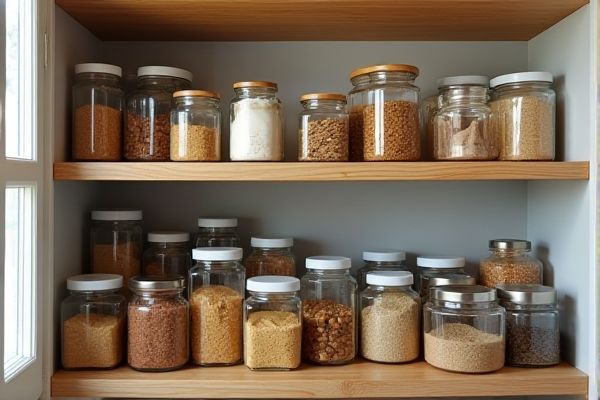
Top shelf storage in a pantry is ideal for lightweight, infrequently used items as it maximizes vertical space and keeps essentials out of direct reach, while bottom shelf storage offers easy access for heavier, bulkier goods and frequently used products. Discover how to optimize Your pantry organization by balancing top and bottom shelf storage strategies in the rest of this article.
Table of Comparison
| Feature | Top Shelf Storage (Pantry) | Bottom Shelf Storage (Pantry) |
|---|---|---|
| Accessibility | Less accessible; requires reaching or stepping | More accessible; easy to reach and organize |
| Visibility | Lower visibility; items can be overlooked | Higher visibility; items are at eye or knee level |
| Weight Limit | Typically holds lighter items | Supports heavier items like canned goods |
| Item Types | Ideal for infrequently used or lightweight items | Best for daily-use or heavy items |
| Safety | Higher risk of falling items | Safer for heavy or bulky items |
| Cleaning | Harder to clean due to height | Easy to clean and maintain |
Introduction to Pantry Shelf Storage
Pantry shelf storage requires strategic organization to maximize space and maintain easy access to frequently used items. Top shelf storage is ideal for lightweight, less frequently accessed products such as bulk goods or extra supplies, while bottom shelf storage accommodates heavier, sturdier containers like canned goods and large bottles for safer retrieval. Your pantry's efficiency depends on balancing the placement of items by weight and usage frequency to optimize convenience and prevent clutter.
Defining Top Shelf Storage
Top shelf storage in a pantry typically refers to the highest area, ideal for items used less frequently such as bulk supplies, extra paper goods, or seasonal ingredients. This space allows you to maximize vertical storage without cluttering immediate access areas, keeping your pantry organized and efficient. Your top shelf is perfect for maintaining order by separating seldom-used items from daily essentials stored at lower levels.
Understanding Bottom Shelf Storage
Bottom shelf storage in a pantry is ideal for heavy and bulky items like canned goods, jars, and large containers that require sturdy support. These shelves tend to be cooler and more stable, making them perfect for products that benefit from consistent temperatures, such as root vegetables or bottles. Organizing your pantry with clear bins or pull-out drawers on the bottom shelf can maximize space and improve accessibility.
Accessibility: Top vs Bottom Shelf
Top shelf storage in your pantry offers excellent visibility for frequently used or lightweight items, ensuring easy access without bending or reaching too low. Bottom shelf storage is ideal for heavier or bulkier items, reducing the risk of spills or strain when lifting, but may require more effort to access. Balancing your pantry with a mix of both optimizes convenience and safety, keeping everyday essentials within easy reach and less-used, heavier goods more stable.
Safety Considerations for Shelf Placement
Top shelf storage in your pantry is ideal for lightweight, non-perishable items to prevent accidents from heavy objects falling. Bottom shelf storage should be used for heavy or bulky items to reduce the risk of injury and ensure stability. Proper shelf placement enhances safety by minimizing strain and avoiding potential hazards from improperly stored goods.
Types of Items Best Suited for Top Shelves
Top shelf storage in a pantry is ideal for items that are lightweight, infrequently used, or require a longer shelf life, such as canned goods, baking supplies, and dry pasta. Storing these less-accessed items on higher shelves helps maximize your pantry's organization and keeps everyday essentials within easy reach on lower shelves. You can optimize your space by reserving bottom shelves for heavier, bulkier items like large containers, bags of flour, or appliances.
Ideal Products for Bottom Shelf Storage
Bottom shelf storage in your pantry is ideal for heavy and bulky items such as large jars, canned goods, and appliances that require sturdy support. These shelves can also accommodate products with longer shelf lives, including root vegetables like potatoes and onions, as they benefit from cooler, darker conditions often found at lower levels. Optimize your bottom shelf by organizing items that are less frequently accessed but need stability and space, ensuring easy reach without cluttering upper shelves.
Maximizing Pantry Space Efficiency
Top shelf storage in pantries is ideal for lightweight, less frequently used items, maximizing vertical space and keeping essentials accessible without cluttering high-traffic areas. Bottom shelf storage accommodates heavier, bulkier goods, preventing accidents and optimizing lower space that might otherwise be wasted. Utilizing adjustable shelving and stackable containers on both shelves enhances overall pantry space efficiency by tailoring storage to item size and usage frequency.
Shelf Storage Organization Tips
Maximize pantry efficiency by placing frequently used items on top shelf storage for easy access and visibility, while heavier or bulkier products belong on the bottom shelves to prevent injury and maintain stability. Utilize clear, labeled containers and adjustable shelf dividers to separate categories and optimize space utilization. Incorporate lazy Susans or tiered organizers to keep small items visible and reduce clutter on both top and bottom shelves.
Choosing the Right Shelf for Your Pantry Needs
Top shelf storage in your pantry is ideal for lightweight, rarely used items like specialty spices or backup supplies, maximizing space and keeping essentials organized out of the way. Bottom shelf storage supports heavier, frequently accessed goods such as bulk items, canned foods, or appliances, ensuring stability and easy reach. Assess your pantry needs by prioritizing accessibility and weight to choose the right shelf for efficient organization and convenience.
 homyna.com
homyna.com